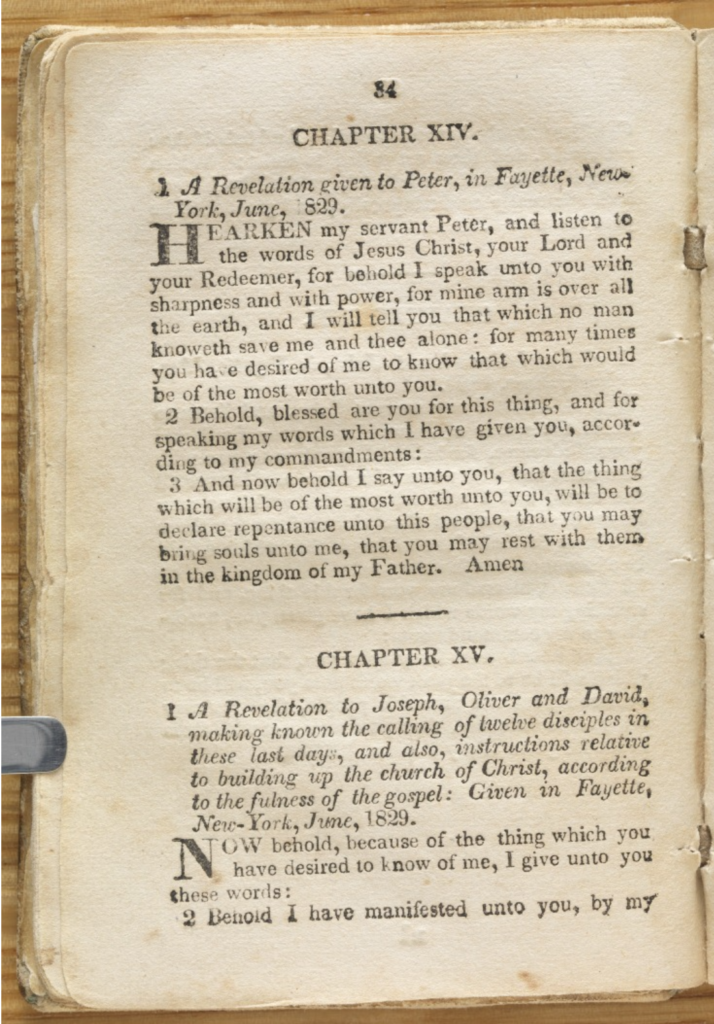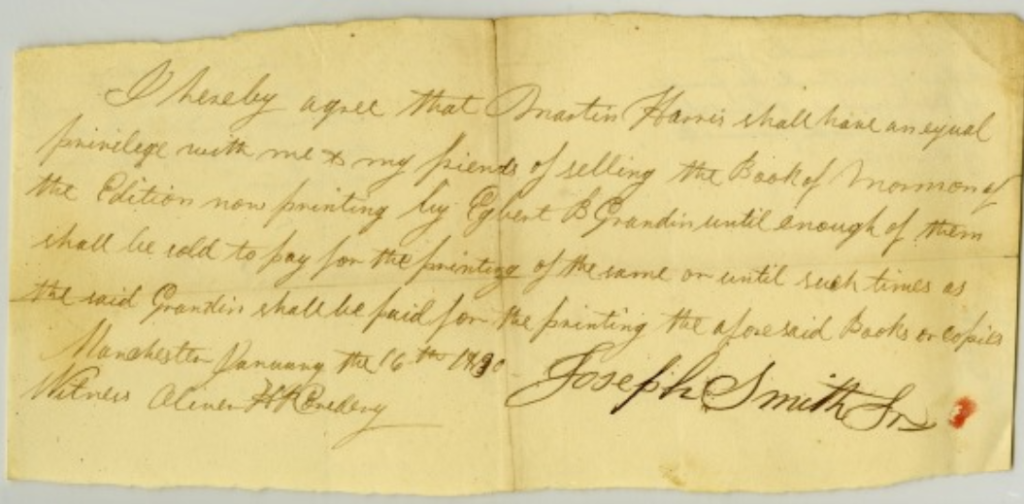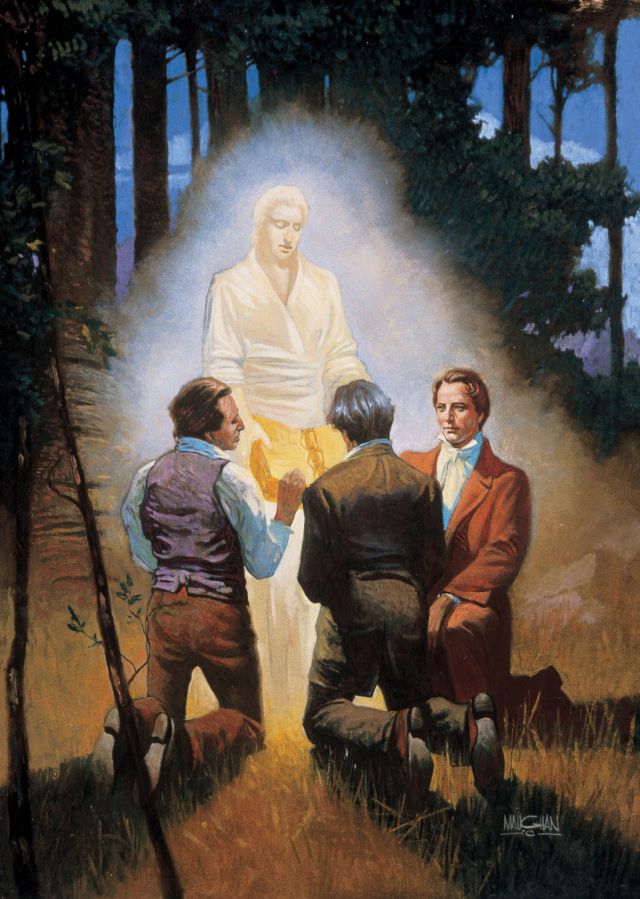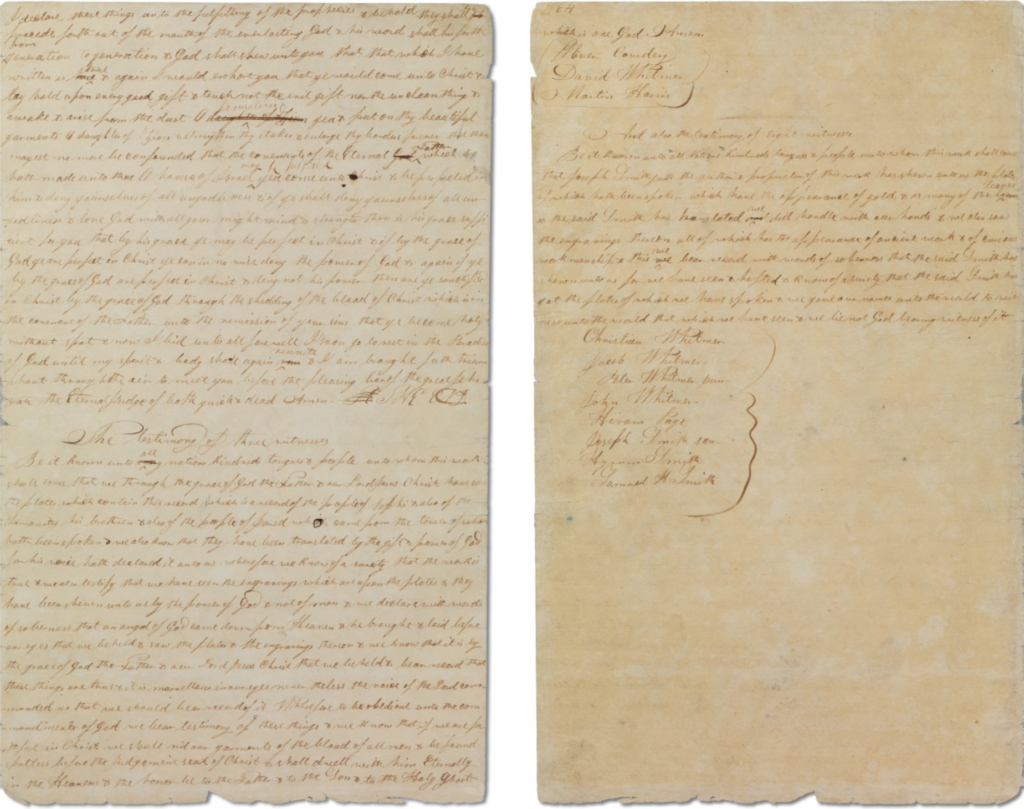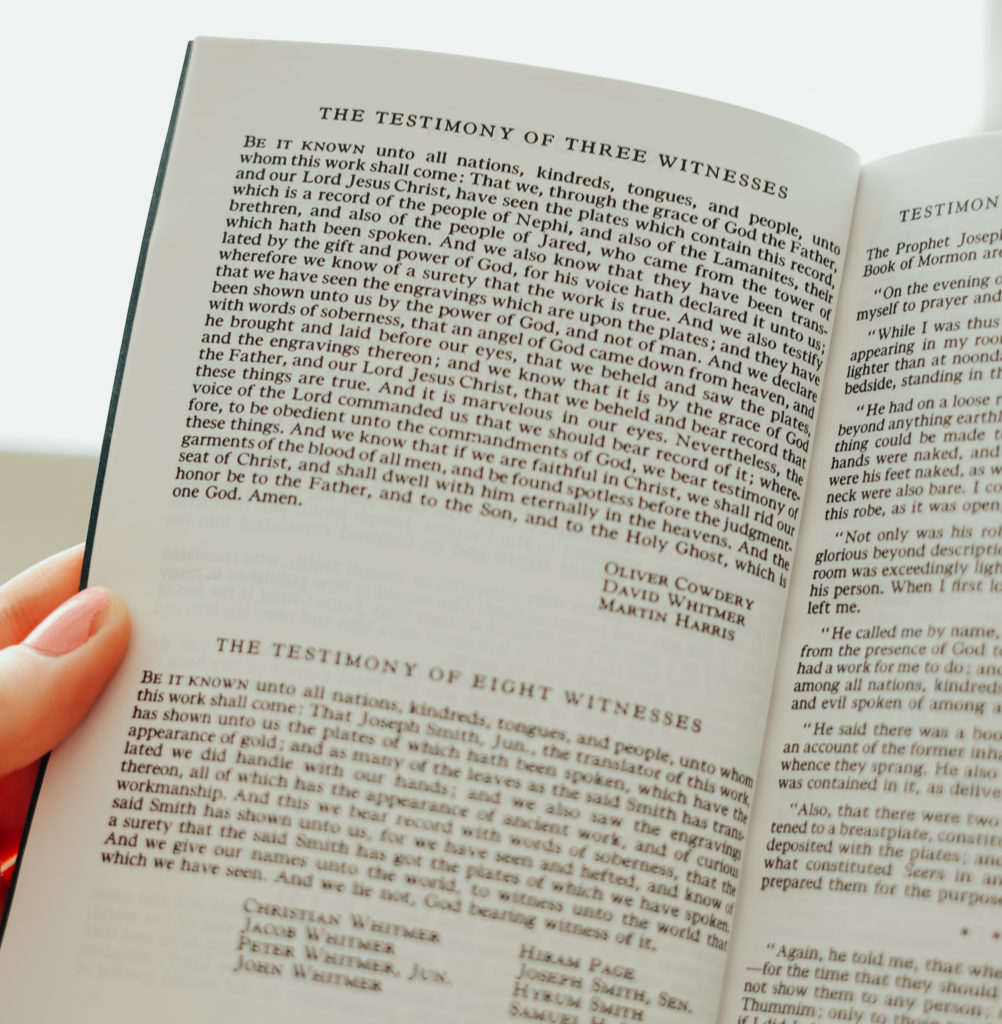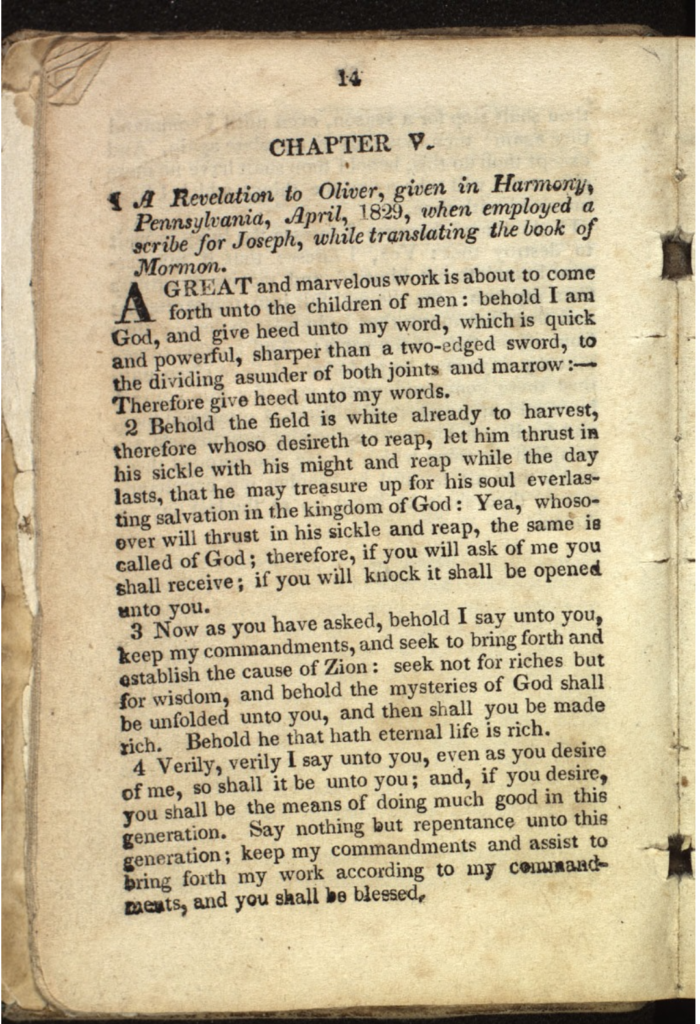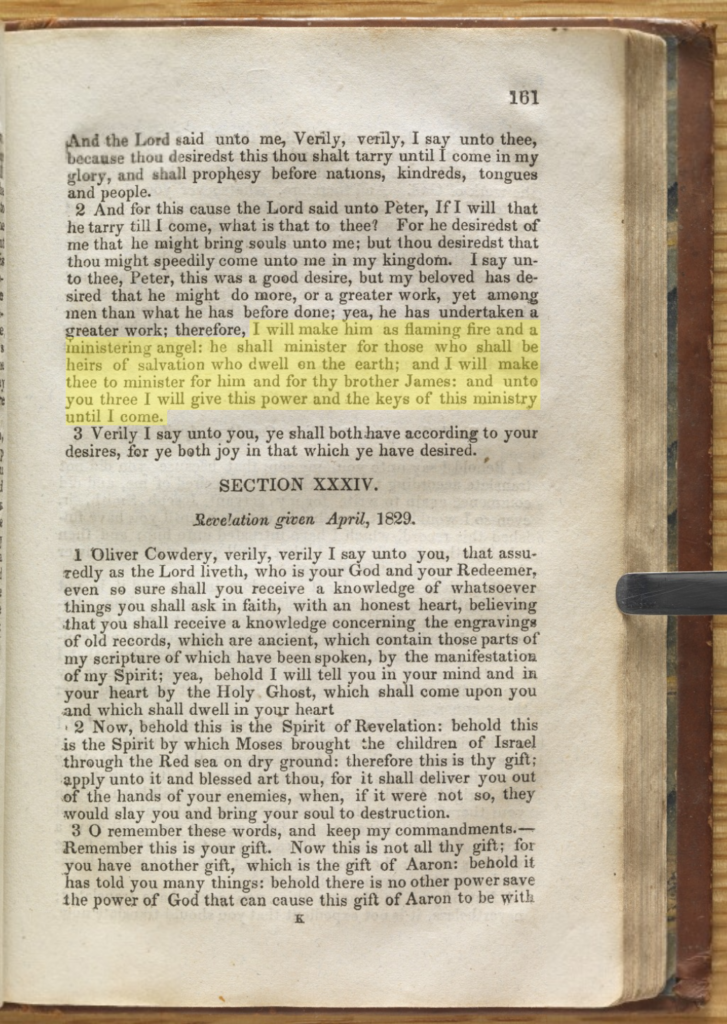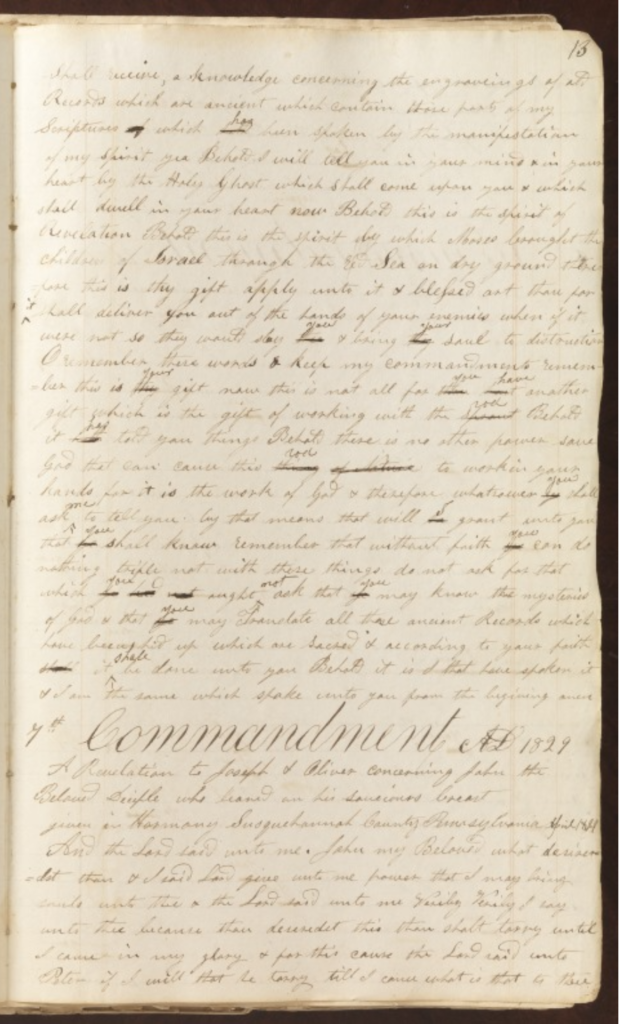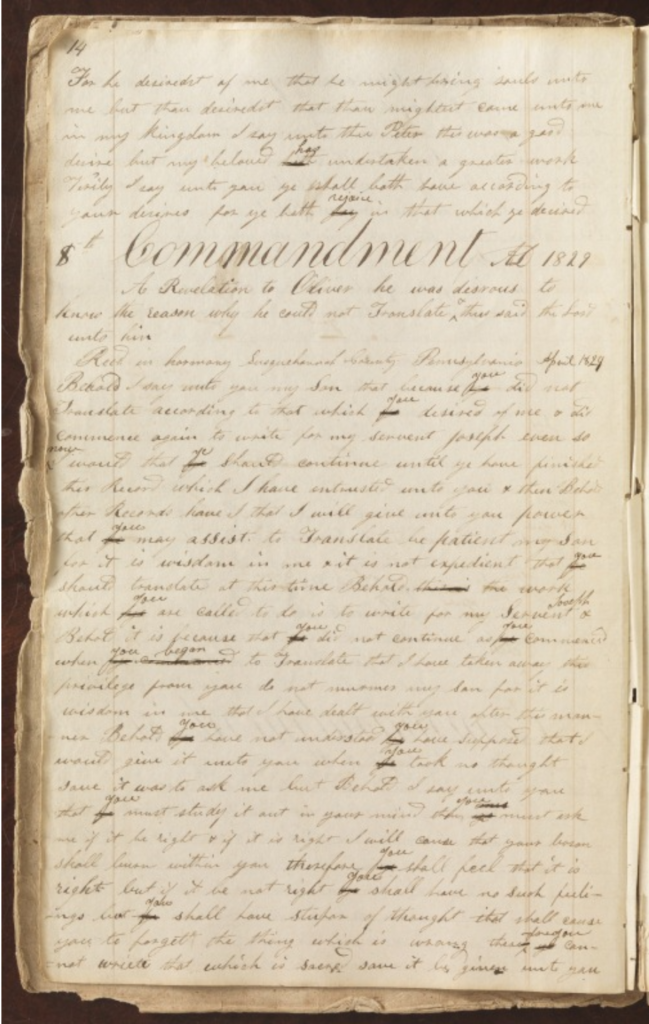Section 30
Section 28 resolved the tension Joseph felt between him and Oliver Cowdery and the Whitmers. The second quarterly conference of the young Church of Christ, held in September 1830 at the Whitmer home in Fayette, New York, culminated when “the Holy Ghost came upon us, and filled us with joy unspeakable; and peace, and faith, and hope, and charity abounded in our midst.” In that setting, Joseph received revelations for Whitmer brothers David, Peter, Jr., and John.
David, the Lord said, had misplaced his devotion and his faith. Rather than loving God with all his mind, he became preoccupied with the things of the earth. Here the Lord is probably not accusing David of being worldly. The Lord uses the word world, as in D&C 1:16, when he wants to describe the fallen earth, to suggest evil, or what we might call worldliness. The revelations use the word earth positively. The world is bad; the earth is good. What, then, is the problem? David’s priorities. He is a farmer. It is harvest time. He is preoccupied with dirt and crops instead of their “Maker.” David is looking down rather than up. His earthly cares have led him to neglect his commission to harvest souls (D&C 14, 17, 18).
Peter remembered that “the word of the Lord came unto me by the Prophet Joseph Smith . . . saying Peter thou shalt go with Brother Oliver to the Lamanites.”[1] Peter covenanted to obey the command, and he did, traveling nearly 1,000 miles, trudging much of it through snow. As with so many missionaries, they did not succeed as they hoped. Baptist missionaries and government agents opposed their efforts, and they eventually returned east without converting any Native Americans. Taking the Book of Mormon to that remnant of Israel would have to wait. Meanwhile the missionaries had great success with another intended audience of the Book of Mormon. “Strange as it may appear,” a northern Ohio newspaper reported, “it is an unquestionable fact, that this singular sect have, within three or four weeks, made many proselytes in this county. The number of believers in the faith, in three or four of the northern townships, is said to exceed one hundred–among whom are many intelligent and respectable individuals.”[2]
The Lord calls John Whitmer to proclaim the gospel like a trumpeter. Using the home of the friendly Philip Burroughs as a headquarters, John is to labor for Zion with his whole soul, preaching the gospel without fear, for the Lord is with him. Early missionaries had success preaching the gospel at the Burroughs home in Seneca Falls, New York.[3] John apparently did so for about six months, from this September 1830 calling until his March 1831 calling to keep a history and transcribe for Joseph (see section 47).
Section 31
Thomas Marsh ran away from home at age fourteen. He made his way to New York City and then to Boston, where he worked in a foundry, making type for printing presses. Later, Thomas and his wife Elizabeth joined Methodism, which satisfied her but not him. He “expected a new church would arise, which would have the truth in its purity.” In 1829, the Holy Ghost led Thomas to take a trip west in search of this new church. In Lyonstown, New York a woman asked Thomas if he had heard of the Book of Mormon. He had not, but wanted to know more. She referred him to Martin Harris in Palmyra. Thomas found Martin at Grandin’s, where the first sixteen pages of the Book of Mormon had just been struck off. Thomas took one of the first copies and went with Martin to the Smith home, where Oliver told him all about the Book of Mormon.
Thomas headed home to tell Elizabeth, who was as excited by the news as he was. When they learned that the Church had been organized in April 1830, they moved to New York, where the Lord revealed section 30 through Joseph to Thomas at the Church’s second quarterly conference in September.[1]
This revelation marked a turning point for Thomas Marsh. His years of seeking the gospel were over. His years of declaring it are about to begin. The revelation’s rich metaphors spoke to Thomas. He served saints who were sick, but at least as important was his work prescribing the gospel of repentance.[2] He was also to be a farmer of souls, to cut and bundle wheat all day long before it grew too late.
Thomas obeyed this revelation falteringly. He helped build the local branch of the church, and when it was time to gather he led them from Fayette, New York to Ohio. The New York saints converged at Buffalo, where the harbor was frozen. Places to stay while waiting for a sufficient thaw were at a premium. Prices were high, supplies low. Conditions were calculated to test Marsh’s willingness to declare the gospel and to try his patience and meekness. “You will be mobbed before morning,” Thomas Marsh told Joseph’s mother Lucy when she refused to keep her faith secret. “Mob it is, then,” she shot back, “for we shall sing and attend to prayers before sunset, mob or no mob.”[3]
Thomas presided unevenly over the quorum of twelve apostles from 1835 until 1838. He led them on a mission to the Eastern United States and tried to heal wounds created by widespread dissent and apostasy in 1837. But then Thomas himself came out against Joseph Smith in 1838 and spent almost two decades outside the church before he wrote to church leaders in 1857, seeking “reconciliation with the 12 and the Church whom I have injured.” Thomas humbly acknowledged, as he wrote, “the Lord could get along very well without me and He has lost nothing by my falling out of the ranks; But O what have I lost?”[4] Reconciled to the Redeemer who gave him Section 31, Thomas died in the faith in 1866.
Section 32
Inspired by the Spirit, Parley Pratt left his Ohio homestead in the summer of 1830 and learned of the Book of Mormon while preaching in western New York. He devoured it, became converted, and went in search of Joseph Smith. He first met Joseph around the time of the September 1830 church conference. During that conference, several of the elders desired very much to know how they could best take the Book of Mormon to the Lamanites. They agreed to ask the Lord whether some of them should go to the Native Americans, whom they assumed were descendants of Lehi.[1]
Oliver Cowdery had already been called to lead such a mission, and Peter Whitmer assigned to join him (Sections 28, 30). Parley remembered that Joseph “inquired of the Lord, and received a revelation appointing me a mission to the west, in company with Oliver Cowdery, Peter Whitmer, Jr., and Ziba Peterson. We started this mission in October, 1830.”[2]
Parley and Ziba took this revelation seriously and worked hard to obey it. On October 17, 1830, they signed a statement that said, “being called and commanded by the Lord God, to accompany our brother Oliver Cowdery to go the Lamanites and to assist in the . . . glorious work and business, we do, therefore, most solemnly covenant before God, that we will assist him faithfully in this thing, by giving heed to all his words and advise, which is, or shall be given him by the spirit of truth, ever praying with all prayer and supplication, for his and our prosperity, and our deliverance from bonds, and imprisonments and whatsoever may come upon us, with all patience and faith.”[3] Joseph’s mother Lucy remembered that “Emma Smith, and several other sisters, began to make arrangements to furnish those who were set apart for this mission, with the necessary clothing, which was no easy task, as the most of it had to be manufactured out of the raw material.”[4] Lucy said that “as soon as those men designated in the revelation were prepared to leave home, they started on their mission, preaching and baptizing on their way, wherever an opportunity afforded.”[5]
Section 33
Some sections of the Doctrine and Covenants highlight the working relationship between personal revelation and prophetic revelation. Section 33 does. Before it was revealed to Joseph, the Lord revealed himself personally to Ezra Thayer, a builder who had employed Joseph before. When he heard Hyrum preach in autumn 1830, Ezra “thought every word was pointed to me. God punished me and riveted me to the spot. I could not help myself. The tears rolled down my cheeks, I was very proud and stubborn. There were many there who knew me, I dare not look up. I sat until I recovered myself before I dare look up. They sung some hymns and that filled me with the Spirit. When Hyrum got through, he picked up a book and said, ‘here is the Book of Mormon.’
I said, ‘let me see it.’ I then opened the book, and I received a shock with such exquisite joy that no pen can write and no tongue can express. I shut the book and said, ‘what is the price of it?’
‘Fourteen shillings’ was the reply.
I said, ‘I’ll take the book.’ I opened it again, and I felt a double portion of the Spirit, that I did not know whether I was in the world or not. I felt as though I was truly in heaven. Martin Harris rushed to me to tell me that the book was true. I told him that he need not tell me that, for I knew that it is true as well as he.”
At home later, Ezra had a vision in which a man brought him a roll of paper and a trumpet, telling him to blow it. Ezra visited Joseph a week after he heard Hyrum preach. “I told him what had happened, and how I knew the book was true.” Ezra wrote. “He then asked me what hindered me from going into the water.”[1] Parley Pratt baptized Ezra Thayer and two others that day, including Northrop Sweet, who was married to a niece of Martin Harris.
Personal revelation prepared these converts for the work. Prophetic revelation to them through Joseph called them to the work.
Oliver Cowdery delivered section 33 to Ezra, who realized then that the roll of paper in his vision “was the revelation on me and Northrop Sweet.” Oliver handed it to him and said, “here is a revelation from God for you, now blow your trumpet.” Ezra protested, “I never blowed a trumpet.” Oliver assured him, “you can.”[2]
Would Ezra and Northrop blow their trumpets as the revelation commanded? Would they let their fears, their lack of refinement and education, keep them from boldly opening their mouths as Nephi did? The revelation’s reference to Nephi, with whom Ezra and Northrop had just become familiar as they studied the Book of Mormon, must have helped them understand that they were being asked to speak the truth boldly to an antagonistic audience—but that they would have success. They could speak as powerfully as Nephi, the Lord assured them, on the condition that they would simply be willing to preach the gospel.
Northrop Sweet chose not to become as Nephi. He did not endure long in his calling. He sought a greater one and thought he received a revelation that he should be a prophet. He left the church and started his own. This is one of several revelations whose promises went unfulfilled because the free agents to whom the Lord declared his will chose to disregard it. Opposed by his wife and others, Ezra Thayer preached the Book of Mormon powerfully but only briefly. He maintained his faith in Joseph Smith for a lifetime, though after Joseph’s death, he too left the Savior’s church. He was often distracted by business and economic concerns. A revelation one cannot obey is the Lord’s responsibility. A revelation the recipients will not obey is their responsibility. “I never blowed a trumpet,” said Ezra in response to the Lord’s command to lift up his voice like a trumpet in declaring the gospel. “You can,” replied Oliver Cowdery.
Section 34
“The greatest desire of my heart,” wrote Orson Pratt of his youth, “was for the Lord to manifest his will concerning me.” In the fall of 1829, eighteen-year-old Orson “began to pray very fervently, repenting of every sin.” Soon two elders, including his older brother Parley, came to his upstate New York neighborhood with the restored gospel and baptized Orson on his nineteenth birthday. “I traveled westward over two hundred miles to see Joseph Smith, the Prophet,” Orson recounted. He found Joseph in Fayette at the Whitmer home, where he asked Joseph for a revelation.[1]
“I well recollect the feelings of my heart at the time,” Orson said many years later. Joseph “retired into the chamber of old Father Whitmer, in the house where this Church was organized in 1830.” Joseph asked Orson and John Whitmer to join him upstairs, where he got his seer stone, put it into a hat, and asked Orson to write what he would say. Orson felt inexperienced and unworthy and asked if John could write, and the prophet said he could.[2]
Orson remembered how “the Lord in that revelation, which is published here in the Book of Doctrine and Covenants, made a promise which to me, when I was in my youth, seemed to be almost too great for a person of as humble origin as myself ever to attain to. After telling in the revelation that the great day of the Lord was at hand, and calling upon me to lift up my voice among the people, to call upon them to repent and prepare the way of the Lord, and that the time was near when the heavens should be shaken, when the earth should tremble, when the stars should refuse their shining, and when great destructions awaited the wicked, the Lord said to your humble servant—‘Lift up your voice and prophesy, and it shall be given by the power of the Holy Ghost.’ This was a particular point in the revelation that seemed to me too great for me ever to attain to, and yet there was a positive command that I should do it.”[3]
The Lord chose Orson as an apostle in 1835 at age twenty-three. As commanded in his youth in section 34, he lifted up his voice long and loud and cried repentance to a crooked generation until he died an old man in 1881. Brigham Young said of Orson, “If you were to chop up Elder Pratt into inch-square pieces, each piece would cry out, ‘Mormonism is true.’”[4]
Section 35
“There was a man whose name was Sidney Rigdon, he having been an instrument in the hand of the Lord of doing much good.” That’s how John Whitmer began the story of section 35 in his history. Sidney “was in search of truth, consequently he received the fullness of the gospel with gladness of heart, even the Book of Mormon”[1] John Whitmer continued, imitating the Book of Mormon: “Now it came to pass, after Sidney Rigdon, was received into this Church, that he was ordained an elder, under the hands of Oliver Cowdery. He having much anxiety to see Joseph Smith, Jr., the Seer whom the Lord had raised up in these last days. Therefore he took his journey to the state of New York, where Joseph resided.”
Arriving in time to hear Joseph conclude a sermon, Sidney asked Joseph to seek revelation to know the Lord’s will for him.[2] “After the Lord had made known what he wanted that his servant Sidney should do, he went to writing the things which the Lord showed unto his servant the Seer.” Joseph revised the Bible as Sidney scribed, giving us some of the most precious scripture ever revealed, including much of the Book of Moses in the Pearl of Great Price.[3]
Joseph and Sidney also obeyed the revelation’s command to form a powerful companionship, with Joseph prophesying and Sidney teaching from the scriptures. They “went to the several churches preaching and prophesying wherever they went,” John wrote, “and greatly strengthened the churches that were built unto the Lord. Joseph prophesied saying: God is about to destroy this generation, and Christ will descend from heaven in power and great glory, with all the holy angels with him, to take vengeance upon the wicked, and they that know not God. Sidney preached the gospel and proved his [Joseph’s] words from the holy prophets.”[4]
Section 36
Edward Partridge grew up in New England. He spent four years apprenticed to a hat maker before becoming a journeyman hatter with ambitions to go west to open his own factory. He married Lydia Clisbee and they moved to Painesville, Ohio and succeeded according to their dreams. But something was missing. Respected and prosperous, Edward and Lydia still lacked spiritual fulfillment. They began to worship with Sidney Rigdon in 1828, and were nearly ripe to hear the restored gospel from Oliver Cowdery, Parley Pratt, and their companions in the fall of 1830. When they offered Edward a Book of Mormon he refused but reconsidered.[1] Soon Edward “partly believed,” as Lydia put it, “but he had to take a journey to New York and see the Prophet.”[2]
Joseph’s mother Lucy picked up the story there. Joseph, she said, was preaching in Waterloo, New York when Edward arrived. Joseph invited remarks after his sermon, and Edward stood and said “he believed our testimony and was ready to be baptized, ‘if, said he, ‘brother Joseph will baptize me.'”[3] Joseph baptized Edward soon thereafter, then received section 36, apparently before Edward was confirmed by Sidney Rigdon.
This revelation shares a theme common to many others. It calls for urgency in declaring repentance to a perverted generation because the Lord is coming soon to burn the wicked. Section 36 not only calls Edward Partridge to preach the gospel, it sets forth the doctrine that every man who is ordained to the priesthood is a missionary by virtue of the ordination. One who is ordained to the priesthood preaches the gospel.
Edward Partridge obeyed this revelation. He was confirmed by the Lord’s hand–that is, by Sidney Rigdon acting for the Lord–and he spent his life declaring repentance and serving as a bishop. In 1835 he traveled roughly two thousand miles, held fifty meetings, visited nearly thirty branches of the church, preached the gospel, and baptized three. On November 7, 1835, Joseph received a un-canonized revelation in which the Lord praised Edward and his companion for “the integrity of their harts in laboring in my vinyard for the salvation of the souls of men.”[4]
Section 30 notes
[1] Peter Whitmer, Jr., Journal, Church History Library, Church of Jesus Christ of Latter-day Saints, Salt Lake City, UT.
[2] Western Courier (Ravenna, Ohio), May 26, 1831. Levi Jackman wrote that “something like one hundred persons joined the Church from that place [Kirtland], with many other branches of the Church organized in adjoining towns and counties. See Jackman, Autobiography, L. Tom Perry Special Collections, Harold B. Lee Library, Brigham Young University, Provo, Utah.
[3] Scot Facer Procter and Maurine Jensen Proctor, editors, Autobiography of Parley P. Pratt, Revised and Enhanced Edition (Salt Lake City: Deseret, 2000), 39. Samuel Smith, Journal, 24 April 1832, Church History Library, Salt Lake City. Lee Yost to Deidrich Willers, 18 May 1897, cited in Larry C. Porter, “A study of the origins of the Church of Jesus Christ of Latter-day Saints in the states of New York and Pennsylvania, 1816-1831,” (PhD dissertation, Brigham Young University, 1971), 109.
Section 31 notes
[1] Millennial Star, 26:24 (June 11, 1864): 375–376.
[2] “History of Thos. Baldwin Marsh,” Deseret News, 24 March 1858, 18.
[3] Scot Facer Proctor and Maurine Jensen Proctor, editors, The Revised and Enhanced History of Joseph Smith by His Mother (Salt Lake City: Bookcraft, 1996), 259-77.
[4] Thomas B. Marsh to Heber C. Kimball, May 5, 1857, Church History Library, The Church of Jesus Christ of Latter-day Saints, Salt Lake City, Utah.
Section 32 notes
[1] “History, 1838–1856, volume A-1 [23 December 1805–30 August 1834],” p. 60, The Joseph Smith Papers, accessed September 25, 2020, https://www.josephsmithpapers.org/paper-summary/history-1838-1856-volume-a-1-23-december-1805-30-august-1834/66.
[2] “History of Parley P. Pratt,” Deseret News, May 19, 1858.
[3] Ezra Booth to Rev. Ira Eddy, 24 November 1831, Nelson, Ohio, in Ohio Star (Ravenna, Ohio), 8 December 1831.
[4] Lavina Fielding Anderson, editor, Lucy’s Book:A Critical Edition of Lucy Mack Smith’s Family Memoir (Salt Lake City: Signature, 22001), 502-03.
[5] Lucy’s Book, 503.
Section 33 notes
[1] “Testimony of Brother E. Thayer Concerning the Latter Day Work, Saints’ Herald 3 (October 1862): 79-80, 82-84.
[2] “Testimony of Brother E. Thayer Concerning the Latter Day Work, Saints’ Herald 3 (October 1862): 79-80, 82-84.
Section 34 notes
[1] Elden J. Watson, compiler, The Orson Pratt Journals (Salt Lake City, by the compiler, 1975), 9.
[2] James R.B. Van Cleave, Richmond, Missouri, to Joseph Smith III, Plano, IL, 29 Sept. 1878. Community of Christ Library and Archives. “History of Orson Pratt,” 10, Historian’s Office, Histories of the Twelve, ca. 1858–1880, Church History Library, Salt Lake City, Utah.
[3] Journal of Discourses, 26 vols. (London and Liverpool: LDS Booksellers Depot, 1855–86), 17:290.
[4] Quoted in Breck England, The Life and Thought of Orson Pratt (Salt Lake City: University of Utah Press, 1985), xi.
Section 35
[1] Book of John Whitmer, chapter 1, Community of Christ Archives, Independence, Missouri.
[2] Lavina Fielding Anderson, editor, Lucy’s Book: A Critical Edition of Lucy Mack Smith’s Family Memoir (Salt Lake City: Signature, 2001), 504-05.
[3] Book of John Whitmer, chapter 1.
[4] Book of John Whitmer, chapter 1, Community of Christ Archives, Independence, Missouri.
Section 36 notes
[1] Richard L. Anderson, “The Impact of the First Preaching in Ohio,” BYU Studies 11:4 (1971): 489.
[2] History of Edward Partridge, Jr., 5, quoted in Anderson, “The Impact of the First Preaching in Ohio,” BYU Studies 11:4 (1971): 493.
[3] Lavina Fielding Anderson, editor, Lucy’s Book: A Critical Edition of Lucy Mack Smith’s Family Memoir (Salt Lake City: Signature, 2001), 504-05.
[4] “Revelation, 7 November 1835,” p. 20, The Joseph Smith Papers, accessed September 25, 2020, https://www.josephsmithpapers.org/paper-summary/revelation-7-november-1835/1.

